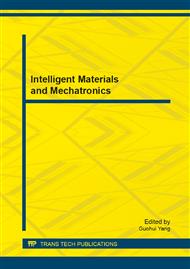p.69
p.73
p.77
p.83
p.89
p.94
p.98
p.105
p.110
Electrical and Structural Properties of Multioriented Thin Film PZT Deposited at Room Temperature by RF-PVD
Abstract:
As PZT target are prepared from solid solution method. The perovskit phase evolution is investigated in this paper by DRX at different temperatures in order to show crystallization, morphology and structure of lead zirconate ceramics (PZT) target. Samples were deposited at room temperature on Aluminum (Al) and silicon (Si) substrates, and then heat-treated in a tabular furnace at 200 and 400°C during 30 min under atmospheric pressure. The films characterization were done glancing incidences X-ray diffraction (GIXRD) analysis with Fe Kα radiation (l=1.936Å ) at glancing angle of 1.5°for crystallographic characteristics; and Scanning Electron Microscopy (SEM-Zeiss ultra plus) in Ultra-High resolution imaging to observe surfaces morphology and cross-sections of thin films.We present in this paper a x-ray diffraction analysis, showing that as-deposited PZT films depend strongly on substrate nature, it presents an amorphous structure and nanocrystallizes in a pure perovskite phase PbZr0.44Ti0.56O3 when it was deposited on Al substrate (followed by thermal treatement at 400°C).Ferroelectrics and piezoelectric properties are showed using Sawyer Tower circuit and impulsionel test respectively.
Info:
Periodical:
Pages:
89-93
Citation:
Online since:
November 2013
Authors:
Keywords:
Price:
Сopyright:
© 2014 Trans Tech Publications Ltd. All Rights Reserved
Share:
Citation:


